九年级英语第一轮复习教案(七上)
人教版中考英语一轮复习复习学案七年级上册Units5-9
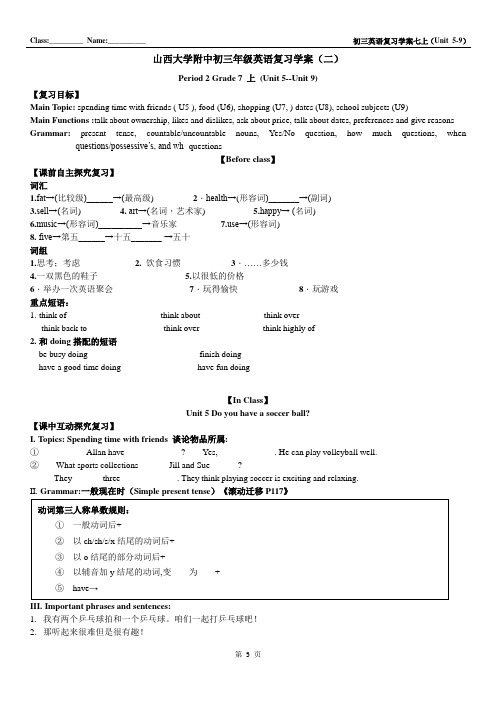
山西大学附中初三年级英语复习学案(二)Period 2 Grade 7 上(Unit 5--Unit 9)【复习目标】Main Topic: spending time with friends ( U5 ), food (U6), shopping (U7, ) dates (U8), school subjects (U9)Main Functions :talk about ownership, likes and dislikes, ask about price, talk about dates, preferences and give reasons Grammar:present tense, countable/uncountable nouns, Yes/No question, how much questions, when questions/possessive’s, and wh- questions【Before class】【课前自主探究复习】词汇1.fat→(比较级)______→(最高级)_______ 2.health→(形容词)_______→(副词)________3.sell→(名词)_______4. art→(名词,艺术家)_________5.happy→ (名词)_______6.music→(形容词)__________→音乐家________e→(形容词)______8. five→第五______→十五_______ →五十_______词组1.思考;考虑___________2. 饮食习惯___________ 3.……多少钱_________4.一双黑色的鞋子__________________5.以很低的价格______________6.举办一次英语聚会________________ 7.玩得愉快______________8.玩游戏___________重点短语:1.think of _______ think about _______ think over _______think back to _______ think over _______ think highly of _______2.和doing搭配的短语be busy doing _______ finish doing _______have a good time doing _______ have fun doing _______【In Class】Unit 5 Do you have a soccer ball?【课中互动探究复习】I.Topics: Spending time with friends 谈论物品所属:①--- ______ Allan have ______ ______? ---Yes, ______ ______. He can play volleyball well.②---What sports collections ______ Jill and Sue ______?---They ______ three ______ ______. They think playing soccer is exciting and relaxing.II.Grammar:一般现在时(Simple present tense)《滚动迁移P117》动词第三人称单数规则:①一般动词后+_____②以ch/sh/s/x结尾的动词后+_____③以o结尾的部分动词后+_____④以辅音加y结尾的动词,变____为____+_____⑤have→_____III.Important phrases and sentences:1.我有两个乒乓球拍和一个乒乓球。
英语人教版七年级上册九年级名词专题复习教案

九年级复习课教案专题一名词第一课时一、说教材1.教材所处的地位和作用:本节复习课的内容在人教版七年级上册第二单元和第六单元所学过。
本节内容是在中考题型第四部分写作里的根据所给单词的适当形式填空里占一定地位。
以及为后面不可数名词和名词所有格的复习打下基础。
2.教学目标:(1)知识与技能目标:复习名词的概念、分类,掌握可数名词变复数的变化规则和名词词组变复数的情况。
(2)过程与方法目标:采用引导探究法,讲授法和小组合作学习的方法来复习巩固可数名词变复数的变化规则和名词词组变复数的情况。
(3)情感态度与价值观目标:通过小组合作归纳总结变化规则,从而更好的培养他们的团队合作意识,互帮互助的精神。
3.教学重点和难点:(1)重点:名词即表示人或物名称的词。
名词的分类, 可数名词变复数的变化规则(2)难点:通过总结可数名词变复数的变化规则,来完成相应的题型。
名词词组变复数的情况。
二、说教法本节复习课我始终坚持“以学生为主体,以教师为主导”的原则,采用导学案并小组合作讨论基础上,运用问题解决式教法,师生互动,课堂讨论演练法。
在采用问答法时,特别注重不同难度的问题,提问不同层次的学生,面向全体,使基础差的学生也能有表现机会,培养其自信心,激发其学习热情。
三、学情分析(说学法)对于初三年级的学生们来说,在第一轮课本复习的时候,已经在人教版七年级上册第二单元和第六单元就学过可数名词变复数的变化规则的运用和习题演练,许多学生出现知识遗忘,所以全面系统的去讲述该知识点;采用小组合作竞争的教学方法,让学生广泛的积极主动参与学习,激发学生兴趣,有效地培养学生能力。
四、教学过程Step 1 Warm-up1.GreetingStep 2 Presentation一、1.本课时复习安排,名词的概念(板书)和名词的分类2.Play a game “ Call a name Say a noun ”3.考一考让学生们写出对下列单词的复数形式,通过课前预习来完成。
人教版九年级英语一轮复习七年级上册5-9单元 学案
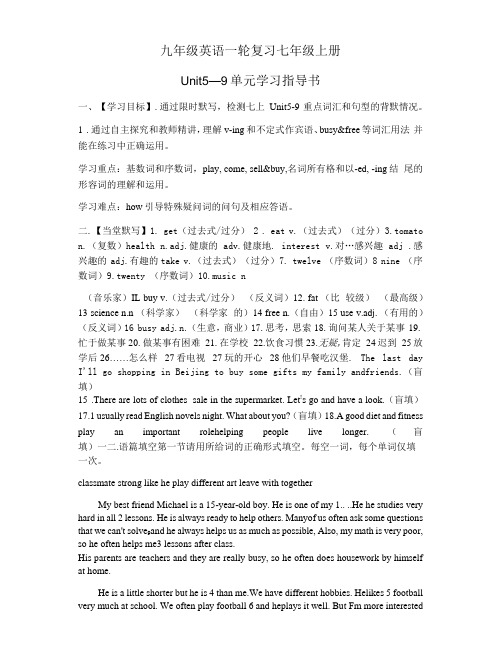
九年级英语一轮复习七年级上册Unit5—9单元学习指导书一、【学习目标】.通过限时默写,检测七上Unit5-9重点词汇和句型的背默情况。
1.通过自主探究和教师精讲,理解v-ing和不定式作宾语、busy&free等词汇用法并能在练习中正确运用。
学习重点:基数词和序数词,play, come, sell&buy,名词所有格和以-ed, -ing结尾的形容词的理解和运用。
学习难点:how引导特殊疑问词的问句及相应答语。
二.【当堂默写】1. get(过去式/过分) 2 . eat v.(过去式)(过分)3.tomato n.(复数)health n.adj.健康的 adv.健康地. interest v.对…感兴趣 adj .感兴趣的adj.有趣的take v.(过去式)(过分)7. twelve (序数词)8 nine (序数词)9.twenty (序数词)10.music n(音乐家)IL buy v.(过去式/过分)(反义词)12. fat (比较级)(最高级)13 science n.n (科学家)(科学家的)14 free n.(自由)15 use v.adj.(有用的)(反义词)16 busy adj.n.(生意,商业)17.思考,思索18.询问某人关于某事19.忙于做某事20.做某事有困难21.在学校22.饮食习惯23.无疑,肯定24迟到25放学后26……怎么样27看电视27玩的开心28他们早餐吃汉堡. The last day I'll go shopping in Beijing to buy some gifts my family andfriends.(盲填)15.There are lots of clothes sale in the supermarket. Let!s go and have a look.(盲填)17.1 usually read English novels night. What about you?(盲填)18.A good diet and fitness play an important rolehelping people live longer.(盲填)一二.语篇填空第一节请用所给词的正确形式填空。
初中英语 人教版初三第一轮复习七年级上册Unit1-3 教案

_________学校七年级上册英语Units__1-3_ 复习教学案思。
考点四、What about this dictionary? 这本字典(是谁的)呢?【用法归纳】What about…?=How about…?意为“……怎么样?”用来征求他人意见或看法,后跟名词、代词或动名词。
【小试身手】---What about _____ a rest?--- Let’s go for a walk.A. to takeB. takeC. taking考点五、That’s my family. Those are my parents. 那是我的家庭。
那些是我的父母亲。
【用法归纳】辨析family, home与house(1)family的意思是“家,家庭”,是一个集体名词。
当把家庭看做一个整体,在句中作主语时,谓语动词用单数;当指家庭的每个成员时,谓语动词用复数。
(2)home的意思是“家”,主要指一个人出生或居住的地方,home也有“家乡、故乡”的意思。
(3)house主要指建筑物、住宅。
【小试身手】Sally considers Wuhan to be her second ______ because she has lived here for 13 years.A. familyB. homeC. house考点六、Thank you for your help, Anna. 谢谢你的帮助,安娜。
【用法归纳】thank you for = thanks for, 意为“因……而感谢。
For是介词,后接名词或动词-ing形式。
【拓展】thanks to …意为“多亏……;由于……”, 相当于because of 或者with the help of……【小试身手】---Thanks for _____ me with my English.--- It’s my pleasure.A. helpB. to helpC. helpingStep 4. 课本同步检测(10 minutes)一、课文填空(每空一词)Hi, I’m Jenny. Here _______ (be) two nice _______(photo) of my family. My grandfather and grandmother are in the _______(one) photo. These are my parents, Alan and Mary. ______ the next picture are my brothers, Bob ______ Eric. _______( This) two girls are my sister Cindy and my cousin Helen.二、完成《中考新航线》P 1 词汇拓展及核心句型。
鲁教版英语九年级一轮复习七年级上下复习教学设计

二、学情分析
针对九年级一轮复习中的七年级上下册英语复习,我们面临的学生群体具有一定的特点。经过七年级的学习,学生已掌握了一定的英语基础,但在复习过程中,我们发现以下学情:
1.学生在词汇方面存在明显差异,部分学生词汇量较大,能够熟练运用所学词汇进行交流;而另一部分学生则词汇量相对较小,对基本词汇的掌握不够牢固。
6.家校合作,共同促进:与家长保持密切沟通,了解学生在家的学习情况,共同关注学生的成长,形成家校共育的良好氛围。
四、教学内容与过程
(一)导入新课
为了激发学生的学习兴趣,将新课引入与学生的生活实际相结合,我设计了一个简短的热身活动。首先,通过多媒体展示一些七年级上下册中出现的关键词汇图片,如家庭成员、日常用品等。然后,邀请学生用英语描述这些图片,并尽量运用已学的词汇和句型。这个活动旨在帮助学生回顾旧知识,为新课的学习做好铺垫。
2.听力:提高学生在实际语境中的听力理解能力,尤其是对语速较快、含有生僻词汇的材料。难点在于培养学生快速捕捉关键信息的能力。
3.口语:培养学生流利、准确地运用英语进行交流的能力。难点在于提高学生的口语表达能力,尤其是对于内向、不善于表达的学生。
4.阅读与写作:提高学生的阅读理解能力,学会分析文章结构和主旨。写作方面,难点在于提高学生的句子结构和词汇搭配能力,使文章通顺、逻辑清晰。
针对以上学情,我们应采取有针对性的教学策略,关注学生个体差异,激发学生的学习兴趣,提高他们的英语综合运用能力。同时,注重培养学生的自主学习能力,帮助他们养成良好的学习习惯,为九年级后续学习打下坚实基础。
三、教学重难点和教学设想
(一)教学重难点
1.词汇与语法:重点复习七年级上下册的核心词汇和基本语法,如动词时态、疑问句、祈使句等。难点在于帮助学生区分不同时态的用法,以及在实际语境中正确运用所学的词汇和语法。
鲁教版英语九年级一轮复习七年级上下复习说课稿

1.七年级上学期:一般现在时、一般过去时、一般将来时;名词、动词、形容词、副词的比较级和最高级;被动语态;there be句型;祈使句、感叹句、疑问句等。
2.七年级下学期:一般现在时、一般过去时、一般将来时;现在进行时、现在完成时;名词、动词、形容词、副词的比较级和最高级;被动语态;状语从句、宾语从句;祈使句、感叹句、疑问句等。
1.通过引入有趣的英语故事或实际案例,让学生感受到英语学习的实用性和趣味性。
2.设计具有挑战性和实际意义的英语任务,如模拟对话、角色扮演等,激发学生的参与热情和求知欲。
3.采用积极评价和激励机制,鼓励学生积极参与课堂活动,增强他们的自信心和成就感。
4.引导学生自主学习,提供丰富的学习资源和学习工具,培养学生的自主学习能力和习惯。
课后作业的目的是帮助学生巩固所学知识,培养自主学习能力和习惯。我计划布置以下作业:
1.要求学生完成相关的阅读理解练习,提高他们的阅读能力。
2.要求学生进行词汇、语法和功能用语的练习,巩固所学知识。
3.鼓励学生进行自主学习,如观看英语视频、阅读英语文章等,拓宽知识面。
五、板书设计与教学反思
(一)板书设计
我的板书设计将注重清晰性、简洁性和知识结构的把握。布局上,我会合理规划板书的区域,将主要内容分为几个部分,如主题、知识点、示例等。风格上,我会采用简洁的文字和图示,以及鲜明的颜色标注关键点,使板书更具吸引力且一目了然。
板书在教学过程中的作用是辅助学生理解和记忆知识点,提供清晰的视觉辅助工具。为确保板书清晰、简洁且有助于学生把握知识结构,我会事先精心准备和练习板书设计,确保在课堂上能够迅速、准确地展示和解释知识点。
选择这些方法的理论依据是现代英语教学理念,即以学生为中心,注重学生的实际应用能力和综合素质的培养。这些教学方法能够激发学生的学习兴趣,调动学生的积极性,促进学生的主动参与和合作,提高学生的英语运用能力和交际能力。
人教版中考英语一轮复习学案七年级上册Units1-4

山西大学附中初三年级七年级(上)英语复习学案(一)Grade 7 (A) (Starter Unit 1--Unit 4)Main Topic: friends ( U1 ), f amily (U2, ), ownership (U3, ) things around the house(U4)家庭,学校,朋友,物品位置Main Functions :Talk about ownership, introducing people and identifying people, where things are 谈论物品所属,介绍他人,识别他人,物品位置Period 1 (Starter Unit 1 --Unit 4)【课前自主探究复习】Independent Review【Before class】词汇one →第一_______→一次__________________this→(对应词)_______ →(复数)_____________ friend→友好的_______ →友谊______________easy→(副词)_______→(反义词)_____________ relax→令人放松的______ →感到轻松的______many→更多的______→最多的______________ help→有益的_____________________________play→播放器;选手_______________________ think→思想______→思想家_________________know→知识__________ →知识渊博的_______词组姓________________________电话号码__________________……怎么样?______________为……而感谢你____________请求;恳求(给予) __________一套;一副________________快点儿____________________看电视____________________飞机模型__________________在第一张照片上___________在沙发上__________________在电视上__________________【课中互动探究复习】Interactive Inquiry【In Class】Starter Unit 1--Unit 3I.Topics:1.询问物品:①---What’s this/that ______ English? ---It’s _____ orange.②---What are these/those? --- ____________ keys.2.询问颜色:--_______________ is this/that quilt? ---It’s purple.II.Grammar:冠词:(Articles)(滚动迁移P14): 分类:__________________ 和___________________。
部编人教版中考英语一轮复习 教案 七上 Unit 1-4

教学难点
一般现在时,主语+谓语+宾语
教学方法
讲、练结合
教学准备
七上课本、练习题
教学过程
教学程序
教学内容
教学构思
一、课堂导入
通过强化成就感,及时总结得失,顺利完成从小学到初中的转变,争取完全上轨道。来询问学生或让学生之间互相询问,复习本节课所需句型。
call sbat+电话号码,以......号码给某人打电话。
Thanks for…“因……而感谢!” Thanks for后面跟名词或者动名词。
【应用】
1. --- Linda, thanks ________ your brother's birthday gift. I'll call him to say "thank you".
【应用】1. ---________ my hat, Mum?--- It is on your head.
A. WhereB. HowC. WhatD. When
2. --- _______ are these? --- They are letters from the US.
A. WhereB. WhyC. WhatD. When
A. ofB. forC. toD. at
3. ---Thanks for ________ me to play basketball. ---You're welcome.
A. teachB. teachingC. teachesD. taught
【答案】1. C 2. D 3. B知识点7:介词短语
新目标初中英语中考总复习第一轮教案(课本知识点)

九年级英语第一轮复习教案九年级全体英语教师整理专用新目标七年级英语(上)期末复习手册Unit1-12重点知识梳理Unit 1✧句子:1.初次见面用语课P2. 2CWhat’s your name? My name is …/ I’m…Nice to meet you !2.问电话号码:What’s your phone number?What’s his/her phone number?It’s 3272310.✧词汇:1.family name, first name, last name✧语法:1. 形容词性物主代词的用法2. 人称代词主格的用法3. 基数词:1至10的读法和写法Unit 2✧句子1.Is this / that your pencil?课P8Yes, it is. No, it isn’t.2. What’s this in English?It’s a pen/ ruler/ book….How do you spell pen/ ruler/book? P-E-N.✧核心知识1. 认识26个字母,辅音字母,元音字母2. 认识一般疑问句的句式✧写作:课P11.3a Found and LostUnit 3✧句子:1.介绍别人或某物This is …That is …These are …Those are …✧词汇:课P131a✧写作:1.学习英语信的格式2.课P17 以信的形式介绍相片中人物Unit 4✧句子询问地方Where is / are …?It’s …/ They are …✧核心知识1. 词汇课P24 12. take 与bring 的区别3. there be 的用法4. on the wall5. 介词:on , in , under , behind ,next to , between…and…6. 认识特殊疑问句的句式✧熟读:P23.3a , P24. 3 , Grammar FocusUnit 5✧句子1. Do you have …?Yes, I do. No, I don’t.2. Does he / she have …?Yes, he / she does. No, he / she doesn’t.3. Let’s …4. That sounds good / interesting.That’s a good idea.5. Welcome to …✧核心知识一、there be 与have 的区别二、一般现在时用法1.现阶段经常性习惯性动作2.目前的状态3.客观真理常用时间状语sometimes, often, every day, usually, always 等构成1.动词用原形I like it.2.当主语是第三人称单数时,动词要加-s(-es)She likes it.He likes it.Ann goes to work.3.be 动词用am,is, areI am a teacher.He is a boy.They are girls.否定形式1.don’t+动词原形I don’t like it.They don’t like it.2.当主语是第三人称单数时,则为:d oesn’t+动词原形He doesn’t like it.Ann doesn’t go to work.一般疑问句把do 或does 放在主语的前面,后面动词用原形Do you like it?Does Ann like it?Does he like it ?附:动词第三人称单数的构成规则情况方法例词一般情况加-s reads, says以ch, sh, x,s或o 结尾的词加-es teaches, guesses finishes以“辅音字母+y”结尾的词把y改为i再加-es fly--fliestry--tries carry--carries✧熟读课本:P25 1a , P26 G.F. ,P27 3b,P28 1a , P30 1与3Unit 6✧句子询问所喜欢的东西1. Do you like….?Yes, I do. No, I don’t.2. Does he like …? Yes, he does. No, he does.✧核心知识1.一般现在时2. 可数名词与不可数名词3. lots of4. go on picnic5. health, healthy, healthily6. P36 1✧熟读课本:P31 1a , P32 G. F. , P35 3a, P36 1Unit 7 ✧句子问价格1. How much is this T-shirt? It’s 10 dollars.2. How much are they? They are 100 dollars.问颜色1. What color do you want ? What color is it? 购物用语:P393a1. Can I help you? What can I do for you?2. Yes, please.3. I’ll take it .4. Thank you.5. You’re welcome.6. Have a look.✧核心知识两位数的基数词读法与写法P40✧熟读课本P37 1c,P38 G. F.,P 39 3a ,P40 1b,P41 3a ,P42 1与3Unit 8✧句子1. When is your birthday?2. My birthday is January fifteenth.3. What year were you born?4. I was born in 1999.5. When were you born?6. I was born in January first,1999.✧核心知识1.基数词和序数词基变序口决基变序有规律,词尾加上-th ;一二三特殊记,单词结尾t d d ;八减t , 九减e , f 要把ve替;ty 把y 改为i , 记住前还有e ;若遇到几十几,只把个位变序。
(word完整版)2019届下学期人教版九年级英语一轮复习七年级上册一轮复习复习导学案79单元
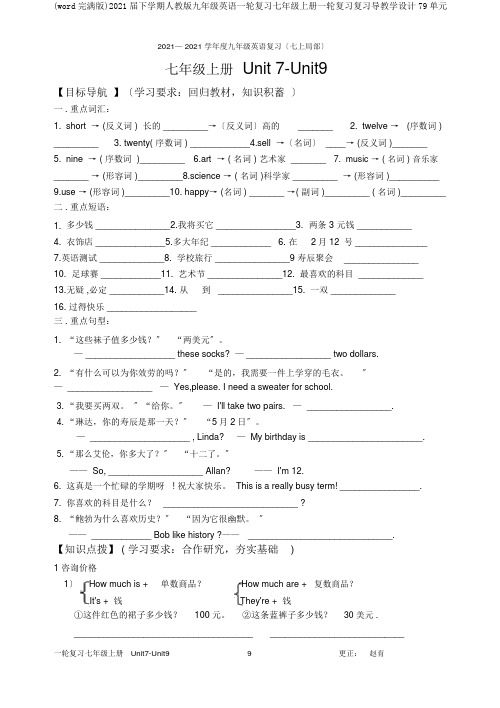
2021— 2021 学年度九年级英语复习〔七上局部〕七年级上册 Unit 7-Unit9【目标导航】〔学习要求:回归教材,知识积蓄〕一 . 重点词汇:1. short → (反义词 ) 长的 _________→〔反义词〕高的_______2. twelve →(序数词 ) _________3. twenty( 序数词 ) ____________4.sell →〔名词〕 ____→ (反义词 )_______5. nine → ( 序数词 )_________6.art → ( 名词 ) 艺术家 _______7. music → ( 名词 ) 音乐家_______ → (形容词 )_________8.science → ( 名词 )科学家 _________ → (形容词 )__________e → (形容词 )_________10. happy→ (名词 ) _______ →( 副词 )_________ ( 名词 )_________二 . 重点短语:1.多少钱 _______________2.我将买它 ________________3.两条 3 元钱 ___________4.衣饰店 ______________5.多大年纪 ____________6. 在2月12号 _______________7.英语测试 _____________8. 学校旅行 _______________9 寿辰聚会_______________10.足球赛 ____________11. 艺术节 _______________12. 最喜欢的科目 _____________ 13.无疑 ,必定 ___________14. 从到 _______________15. 一双 _____________16. 过得快乐 __________________三 . 重点句型:1.“这些袜子值多少钱?〞“两美元〞。
九年级一轮复习(七年级课本上)

九年级英语第一轮复习(课本)复习学案七年级(上)Units 1---6目标再现:1.掌握这6个单元的重点词汇、短语,能听、说、读重点句型。
2.能运用所学的知识来介绍人物、询问物主、寻找物品、谈论喜好等。
课前加油站:一.熟记词汇( 课前熟记6个单元的重点词汇,准备课上迎接挑战):二.重点短语(课前复读课文,与短语老朋友热情相见):用英语电话号码一套、一副为……而感谢看电视玩电脑游戏失物招领踢足球姓氏听起来不错把……带给…… 健康食品拨打….找某人三.语法必备3.名词复数4.方位介词(in , on , under , behind )5.动词(be , have)6.不定冠词(a , an )链接中考1.(2010河北)Cindy is amazing singer. She has lots of fans.A aB anC theD 不填2.(2010河北)Sally is very happy . There is a big smile her face.A onB toC inD at3.(2010北京)The reading room very quiet .I enjoy reading books there.A amB isC areD be4. (2010湖南)Thank you for me to your party.A inviteB to inviteC invitingD invites5. (2009河北)The silk dress so smooth . It’s made in China.A tastesB smellsC soundsD feels最大最全最精的教育资源网 Array新世纪教育网天量课件、教案、试卷、学案免费下载第2 页共 2 页。
人教版九年级英语第一轮复习 Units1-4 复习学案

九年级英语一轮复习七年级上册Unitl—4单元学习指导书一、【学习目标】L通过限时默写,检测七上Unitl-4重点词汇和句型的背默情况。
2,通过自主探究和教师精讲,理解be动词、help等词汇的用法并能在练习中正确运用。
学习重点:help> thanks for> ask、代词的五格和but语法点的理解和运用。
学习难点:人称代词,物主代词等在具体语境中的正确运用。
二、【基础当堂检测】:1.photo-(复数)2.dictionary-(复数)3.radio-(复数)4.see-(过去式)(过去分词)5.teach-(过去式)(过去分词)(n.老师)6.find- (过去式/过去分词)7.(丧失)- (过去式/过去分词)8.know-(过去式)(过去分词)9.watch (n)(复数)(v.)-(单三)-(过去式/过去分词)lO.spell-(过去式)-(过去分词)1L和…交朋友12.拍照13看见Lucy正在跳舞14.教学生画画15 .擅长打篮球16.在老师的帮助下17.我把我的校园卡弄丢了,我必须找到它。
请拨打6082-2022找我.18.这本书不是我的,是Mary 的19.--这个长头发的女孩是你姐姐吗?一不,她不是。
她是我的朋友。
20.一谢谢你帮助我.三.[自主探索]1. Thank you for your help, Anna.安娜,谢谢你的帮助。
(Unit3 P14)【备考分析】l)thanks for注意:Thanks for...常用答语有:You are welcome./ That's all right. /It's my pleasure./Not at all./Never【牛刀小试】1.A: Thanks for(send) me such a nice birthday present, I like it very much.B: .2.Thanks thousands of doctors and nurses, the new pneumonia patients can geteffective treatment. Every Chinese man is them.2)Help v.帮助Can you help me (to) learn English?你能帮助我学习英语吗?Please help me with my French.请帮助我学法语Help yourselves to the fruit.诗随便吃些水果。
中考英语第一轮复习教案(七上)

九年级英语第一轮复习教案(七上)教学目标:1. 职业名称及工作场所;询问职业2. 复习现在进行时3. 树状家谱;复习家庭成员及名词所有格4. 询问价格5. 复习询问时间及时间表达法教学重点:1. 职业名称及工作场所;询问职业2.复习家庭成员及名词所有格3.复习询问时间及时间表达法教学步骤:Step1.重点词汇拓展spelt/spelled saw seen met meeting first onceHelpful found taught thought knowledgeStep2.The important phrases.in English first name middle schoolhurry up under the chairStep3.The important sentencesWhat's this Excuse meThank you forYou're welcomeCall me atStep4.常见考点辨析►with【精析拓展】with的常见用法如下:①意为“和……在一起”;②意为“具有;带有”,介词短语常用作后置定语;③意为“用”,表示用某种工具;④表示伴随,作状语。
相关短语归纳:with the help of sb.=with one's help在某人的帮助下help sb. with sth.在某事上帮助某人be strict with sb.对某人要求严格provide sb. with sth.为某人提供某物be angry with对……生气get on well with与……相处融洽to start with起初;开始时be born with天生具有deal/do with处理agree with sb.同意某人【活学活用】1)My English teacher is always strict ________ us.(2016,攀枝花) A.in B.at C.with D.about2)—Do you remember what she looked like when you first met her? —Of course. She was tall and thin ________ long hair.(2015,福州) A.in B.with C.on►What's your name?你叫什么名字?What do you often do on weekends?周末你经常做什么?What does she do?/What's she?她的职业是什么?What color is your shirt?你的衬衫是什么颜色的?What size of shoes do you want?你要多大码的鞋子?What kind of movies do you like?你喜欢哪种电影?【活学活用】1)—________ is your father?—He's an engineer in a big factory.(2016,东营)A.Who B.What C.Which D.Where2)—Look at the man in blue. Do you know ________?—Oh,he is a policeman.(2016,哈尔滨)A.what does he do B.what he doesC.how he does►good ,well【活学活用】1)—Have some ice-cream,please.—Mm,it tastes ________.(2018,娄底)A.good B.better C.well2)This kind of T-shirt looks and sells ________ in the market.(2015,安顺) A.nice;good B.well;wellC.nice;well D.good;nice►family house home►look for find find outStep5考点综合检测Step6考点跟踪突破Step7温馨提示:Boys and girls, It is the best time for us to studynow.Time waits for no man. Don't use your timecarelessly.You can't call them back.Don't be afraid tolearn.Knowledge is a treasure you can always carryeasily. So we should study much harder . OK!Let'swork hard to make our dreams come true!(光阴似箭,岁月不等人。
中考英语第一轮复习教案七篇
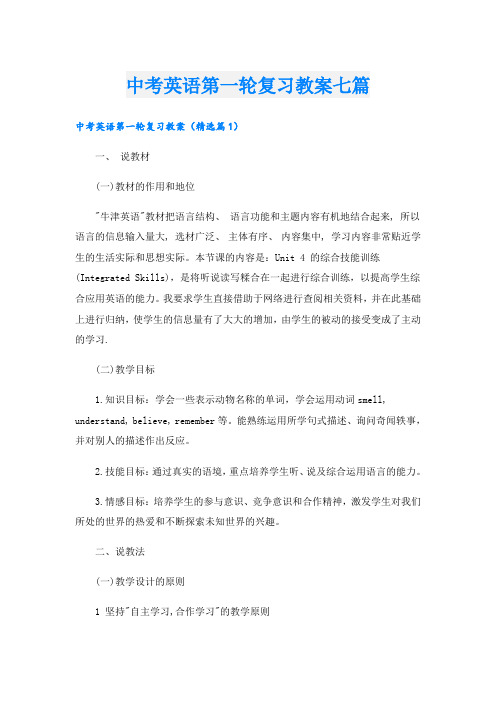
中考英语第一轮复习教案七篇中考英语第一轮复习教案(精选篇1)一、说教材(一)教材的作用和地位"牛津英语"教材把语言结构、语言功能和主题内容有机地结合起来, 所以语言的信息输入量大, 选材广泛、主体有序、内容集中, 学习内容非常贴近学生的生活实际和思想实际。
本节课的内容是:Unit 4 的综合技能训练(Integrated Skills),是将听说读写糅合在一起进行综合训练,以提高学生综合应用英语的能力。
我要求学生直接借助于网络进行查阅相关资料,并在此基础上进行归纳,使学生的信息量有了大大的增加,由学生的被动的接受变成了主动的学习.(二)教学目标1.知识目标:学会一些表示动物名称的单词,学会运用动词smell, understand, believe, remember等。
能熟练运用所学句式描述、询问奇闻轶事,并对别人的描述作出反应。
2.技能目标:通过真实的语境,重点培养学生听、说及综合运用语言的能力。
3.情感目标:培养学生的参与意识、竞争意识和合作精神,激发学生对我们所处的世界的热爱和不断探索未知世界的兴趣。
二、说教法(一)教学设计的原则1 坚持"自主学习,合作学习"的教学原则教师打破了以教师为中心, 单项灌输的陈旧模式, 在课堂教学中尽可能发挥学生的主动性和合作精神, 营造了良好的学习氛围, 更重要的是在频繁的交流中, 学生的语言表达能力提高了。
2 遵循英语教学的交际性原则交际性原则是英语教学中的一个指导性原则, 教学最终的目的不仅要使学生掌握知识, 更重要的是使学生在理解的基础上, 在交际性练习中培养交际能力,而培养这种交际能力, 就是反映在课堂教学中学生以主人翁态度, 积极、主动、大胆地参与英语课堂练习活动的主体意识上。
3 追求和谐的课堂活动学生主体性的发挥, 要在民主, 平等的氛围中体现, 更要在科学, 和谐的教学活动中进行. 课堂教学不仅要处理好老师、学生、教材等关系, 还要尽可能地发挥三者各自的特长, 这就是教学的化。
九级英语第一轮复习教案人教版

③结合学生兴趣,引入与课程相关的小故事或实例,使板书设计更具趣味性,激发学生的学习兴趣和主动性
(3)阅读理解:本节课的重点是提高学生的阅读理解能力,通过阅读九年级英语课本中的重点文章,培养学生的快速阅读、准确理解和深度分析的能力。
(4)写作技能:本节课的重点是提高学生的写作技能,包括句子结构、段落组织、文章布局等。学生需要通过练习写作,掌握英语文章的基本结构和写作技巧。
2.教学难点
(1)词汇复习:学生在词汇学习中往往存在记忆不准确、拼写错误等问题,需要教师通过各种教学方法帮助学生巩固记忆,提高词汇运用能力。
教学难点与重点
1.教学重点
(1)词汇复习:本节课的重点是复习和掌握九年级英语课本中的重点词汇。这些词汇包括动词、名词、形容词、副词等,如:communicate, understand, importance, actively等。
(2)语法复习:本节课的重点是复习和掌握九年级英语课本中的重点语法知识,包括时态、语态、非谓语动词等。例如:现在进行时、被动语态、不定式等。
教学资源准备
1.教材:确保每位学生都有九年级英语课本和配套练习册,以便于跟随教学进度进行学习和复习。
2.辅助材料:准备与教学内容相关的多媒体资源,包括图片、图表、视频等。例如,在复习词汇时,可以准备相关的图片和例句,帮助学生更好地理解和记忆词汇。在复习语法时,可以准备相关的图表和示例,清晰地展示语法规则。在阅读理解环节,可以准备相关的视频或音频材料,提供更多的信息来源,拓宽学生的视野。
教师总结各组的亮点和不足,并提出进一步的建议和改进方向。
6.课堂小结(5分钟)
目标:回顾本节课的主要内容,强调九级英语复习的重要性和意义。
中考英语(人教新目标)一轮复习方案第一部分 第2课时 七年级上册 Unit 5~Unit 9

基础自查考点汇聚源自随堂演练课后作业20.fat (adj.) 肥的;肥胖的 (n.) 脂肪;肥肉→fatter (比较级) 较胖的 →fattest (最高级) 最胖的
21.much (pron.& adj.) 许多;大量;多少→more (比较级)更多→most (最 高级)最多
22.shoe (n.) 鞋→shoes (pl.) 23.big (adj.) 大的;大号的→bigger (比较级)更大的→biggest (最高级) 最大的→small (反义词)小的;小号的 24.long (adj.) 长的→length (n.) 长;长度 25.woman (n.) 女子→women (pl.)
基础自查
考点汇聚
随堂演练
课后作业
描述词 1.small (adj.) 小的;小号的 2.short (adj.) 短的;矮的 3.all (adj.) 所有的;全部的 4.cool (adj.) 妙极的;酷的 5.favorite/favourite (adj.& n.)
特别喜爱的(人或事物)
基础自查
基础自查
考点汇聚
随堂演练
课后作业
14.easy (adj.) 容易的;不费力的→easily (adv.) 容易地→easier (比较 级)→easiest (最高级)
15.tomato (n.) 西红柿→tomatoes (pl.) 16.eat (v.) 吃→ate (过去式)→eaten (过去分词) 17.well (adv.) 好;令人满意地→better (比较级)较好地;更好地→best (最 高级)最好地 18.healthy (adj.) 健康的→health (n.) 健康→healthily (adv.) 健康地 19.really (adv.) 真正地→real (adj.) 真的;真正的
鲁教版英语九年级一轮复习七年级上下复习优秀教学案例
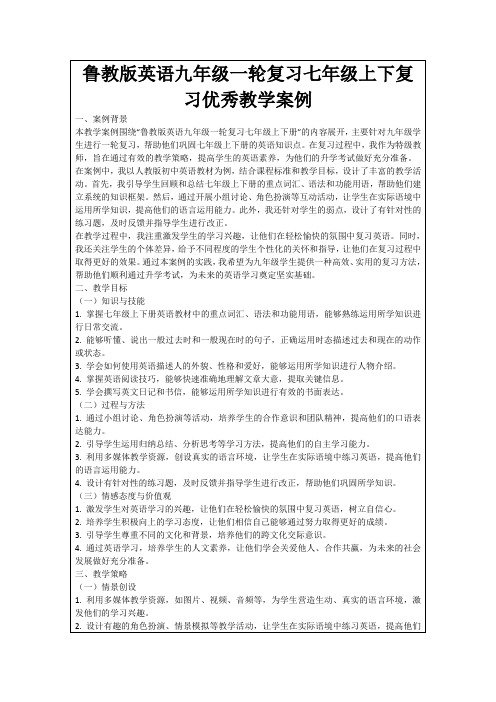
(三)学生小组讨论
在学生对一般过去时和一般现在时有了基本的理解后,我组织学生进行小组讨论。我给他们提供了一些问题,如:“你们能用一般过去时和一般现在时描述一下自己的日常生活吗?”、“你们认为一般过去时和一般现在时在交流中有什么不同?”等。通过小组讨论,学生可以巩固所学的知识,并培养他们的合作意识和口头表达能力。
4.设计有针对性的练习题,及时反馈并指导学生进行改正,帮助他们巩固所学知识。
(三)情感态度与价值观
1.激发学生对英语学习的兴趣,让他们在轻松愉快的氛围中复习英语,树立自信心。
2.培养学生积极向上的学习态度,让他们相信自己能够通过努力取得更好的成绩。
3.引导学生尊重不同的文化和背景,培养他们的跨文化交际意识。
4.通过英语学习,培养学生的人文素养,让他们学会关爱他人、合作共赢,为未来的社会发展做好充分准备。
三、教学策略
(一)情景创设
1.利用多媒体教学资源,如图片、视频、音频等,为学生营造生动、真实的语言环境,激发他们的学习兴趣。
2.设计有趣的角色扮演、情景模拟等教学活动,让学生在实际语境中练习英语,提高他们的语言运用能力。
3.鼓励小组成员相互尊重、相互帮助,让每个学生在合作中取得更好的学习效果。
4.教师要关注小组合作的过程,及时发现并解决问题,确保小组合作的效果。
(四)反思与评价
1.引导学生定期对自己的学习进行反思,分析自己的优点和不足,制定改进措施。
2.教师要关注学生的学习进步和变化,及时给予肯定和鼓励,提高他们的自信心。
在案例中,我以人教版初中英语教材为例,结合课程标准和教学目标,设计了丰富的教学活动。首先,我引导学生回顾和总结七年级上ቤተ መጻሕፍቲ ባይዱ册的重点词汇、语法和功能用语,帮助他们建立系统的知识框架。然后,通过开展小组讨论、角色扮演等互动活动,让学生在实际语境中运用所学知识,提高他们的语言运用能力。此外,我还针对学生的弱点,设计了有针对性的练习题,及时反馈并指导学生进行改正。
九年级英语复习七年级上1-6复习教案

七年级英语学科(上册))第 1 课时 Units1-6张守娟释疑点拨1.English name :family name =last name 姓first name ,given name 名字eg. Yao Ming is a great basketball player ,his family name isYao , his first name is Ming.John henry brown is a singer ,his family name is Brown,his first name is John.2.指示代词:this /these that /thoseeg.①This book is Tom’s. That book is mine.②Those pens are new ,these pens are old.This man is my unlce.变为复数句子These men are our uncles.Those teachers work hard. 变为单数句子That teacher works hard.3.方位介词: in ,on ,behind ,under ,near ,in front of ,next tobetween ...and ... across fromeg. Where is the library ? It’s between the hospital and thepost office?My pen is on the desk.His books are in his backpack..Li Lei sits next to JimShandong is in the east of China.Japan is to the east of China.4一般现在时:定义:表示现在存在的状态,也可表示经常或习惯性的动作,或者主语具备的性格和能力等。
- 1、下载文档前请自行甄别文档内容的完整性,平台不提供额外的编辑、内容补充、找答案等附加服务。
- 2、"仅部分预览"的文档,不可在线预览部分如存在完整性等问题,可反馈申请退款(可完整预览的文档不适用该条件!)。
- 3、如文档侵犯您的权益,请联系客服反馈,我们会尽快为您处理(人工客服工作时间:9:00-18:30)。
上课时间:年月日备课人:累计课时:1
上课时间:年月日备课人:累计课时:2
上课时间:年月日备课人:累计课时:3
上课时间:年月日备课人:累计课时:4
上课时间:年月日备课人:累计课时:5
一初中九年级英语学科教案
上课时间:年月日备课人:累计课时:6
一初中九年级英语学科教案
上课时间:年月日备课人:累计课时:7
一初中九年级英语学科教案
上课时间:年月日备课人:累计课时:8
一初中九年级英语学科教案上课时间:年月日备课人:累计课时:
一初中九年级英语学科教案上课时间:年月日备课人:累计课时:
一初中九年级英语学科教案
上课时间:年月日备课人:累计课时:11
一初中九年级英语学科教案上课时间:年月日备课人:累计课时:。
